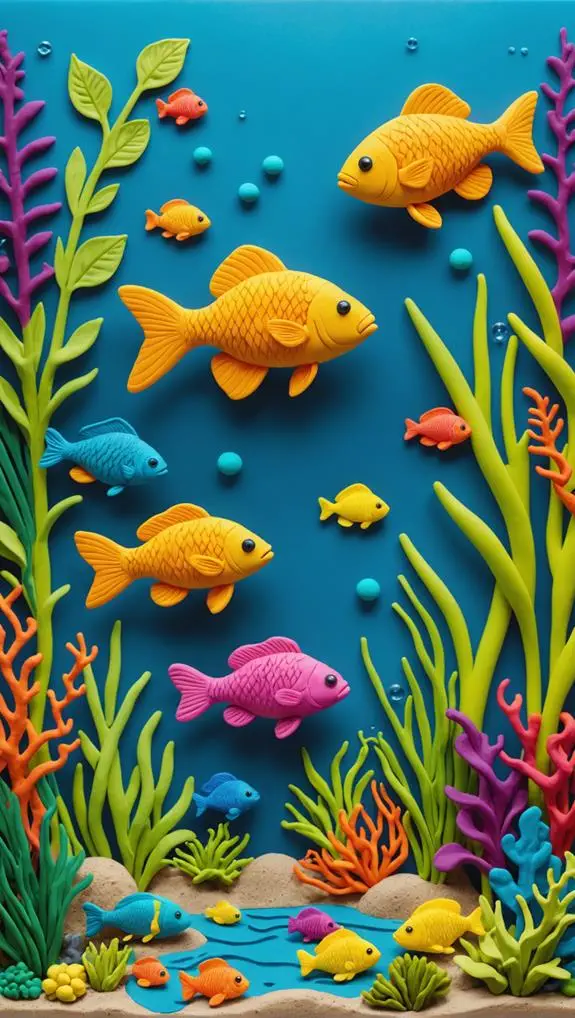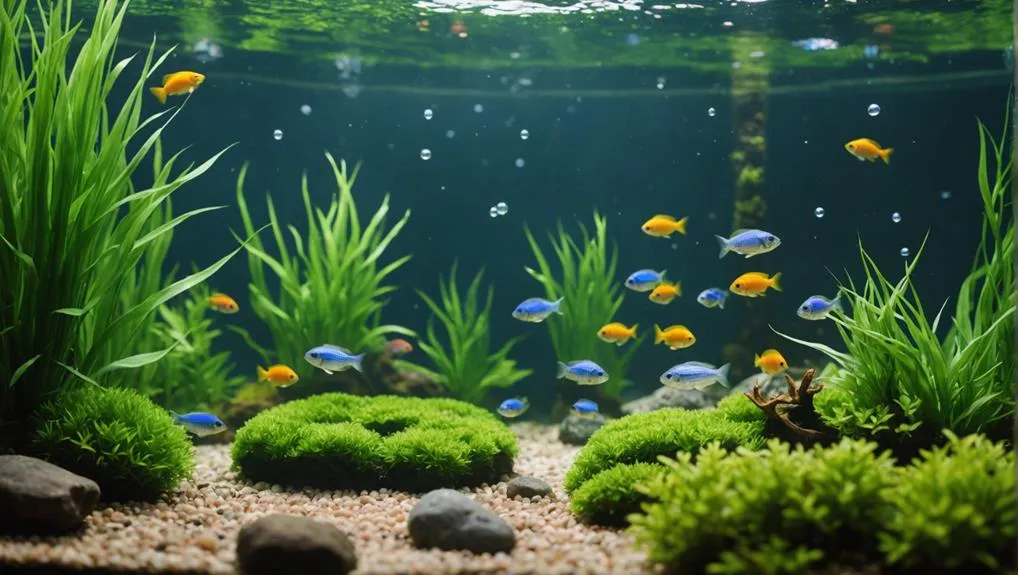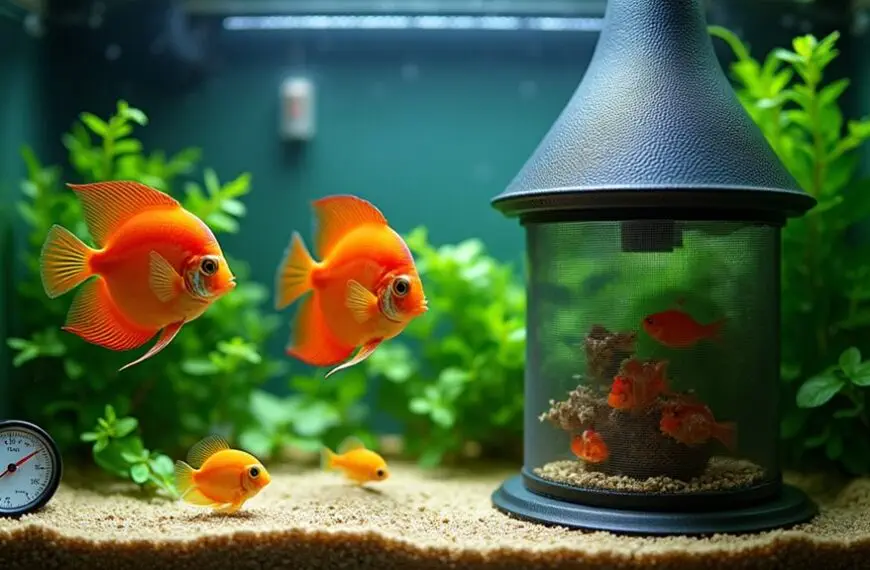Freshwater fish breeding cycles can be pretty fascinating! These critters typically lay eggs or give live birth, and their methods depend on species and environment. Most fish release their eggs and sperm simultaneously in water—talk about teamwork! They're influenced by factors like temperature and oxygen levels, which can really make or break their breeding success. Once the eggs are laid, there's a high chance many won't survive due to predators or poor conditions. Fish have clever strategies to improve their odds, too. Stick around, and you'll discover more about these watery wonders and their amazing life journeys!
Contents
- 1 Anatomy of Reproductive Organs
- 2 Reproductive Strategies Overview
- 3 Egg and Sperm Dynamics
- 4 Spawning and Fertilization
- 5 Life Cycle Stages
- 6 Environmental Influences on Breeding
- 7 Unique Freshwater Species Strategies
- 8 Challenges to Reproductive Success
- 9 Fish Production Cycle Insights
- 10 Frequently Asked Questions
- 11 Final Thoughts
Anatomy of Reproductive Organs
The reproductive organs of freshwater fish are fascinating in their complexity and function. Just think about it—female fish have two ovaries where they produce eggs. These eggs are released into the water, but in some cases, they're fertilized internally. Isn't that cool?
The maturation of those oocytes involves changing shapes and sizes, much like a caterpillar transforming into a butterfly!
Now, male fish are equally interesting. They typically have two testes that create sperm, which is delivered through a sperm duct to the urogenital opening. This setup allows for external fertilization, where the magic happens in the water.
Some species, like cichlids, take parenting to the next level. They've got special adaptations, like mouthbrooding, where they protect their fertilized eggs in their mouths until they hatch. Talk about a committed parent!
With freshwater fish laying thousands of eggs, they're definitely playing the numbers game. After all, the more eggs they produce, the better the chances of some surviving the many challenges they face.
It's a wild world out there, and their reproductive anatomy is perfectly designed for survival!
Reproductive Strategies Overview
When you think about how freshwater fish reproduce, it's fascinating to see the variety of strategies they use. Some lay tons of eggs, while others keep their little ones close, showing off a mix of egg-laying and live-bearing methods.
Plus, environmental factors like temperature can really shake things up, influencing when these fish decide it's time to mate—nature sure knows how to keep us on our toes!
Fertilization Methods Comparison
Fertilization methods in freshwater fish vary significantly, showcasing diverse reproductive strategies tailored to their environments. Most species of fish, like those in your local pond, engage in external fertilization. Here, females release a bunch of fertilized eggs into the water while males simultaneously release sperm. This teamwork boosts the chances of the embryos surviving pesky predators.
In many of these fish, such as those that lay their eggs on aquatic plants, those fertilized eggs come with a sticky bonus. They cling to surfaces, making it harder for currents to whisk them away.
On the flip side, some species, like the migratory freshwater eel, are quite the travelers, swimming to specific spots where conditions are just right for spawning.
Now, not all fish follow the crowd. A few, like guppies, practice internal fertilization—where eggs get fertilized inside the female's body, leading to live births. This method often results in fewer offspring, but hey, quality over quantity, right?
Egg-Laying vs. Live-Bearing
Freshwater fish showcase two primary reproductive strategies: egg-laying and live-bearing. When you look at egg-laying fish, like goldfish and cichlids, you'll notice they release a ton of eggs into the water. This method, known as oviparity, means the eggs get fertilized externally.
Unfortunately, only a small fraction of those eggs will survive to become adults, which can feel a bit like a fishy lottery!
On the flip side, you have live-bearing fish, such as guppies and surfperches. These little swimmers give birth to fully formed or developing young ones, making them a bit more nurturing.
Internal fertilization helps here, as males use special structures to transfer sperm directly to females. This means the chances of the young surviving are higher, and who doesn't love a happy ending?
Both methods have their quirks and benefits, adapting to different environments. Whether it's a flurry of eggs or a proud parent showcasing their young, each strategy highlights the amazing diversity of freshwater fish.
Environmental Influences on Reproduction
Environmental factors play a crucial role in determining how and when freshwater fish reproduce. These fish are quite attuned to their environment, adjusting their breeding cycles based on things like water temperature and oxygen levels. For instance, goldfish kick off their breeding season as temperatures rise, while carp wait for the perfect amount of oxygen. It's like they've their own little calendar!
Spawning triggers can vary significantly among species, but they all have one thing in common: they need the right conditions to thrive. Aquatic vegetation is essential for successful reproduction. It provides safe havens for eggs, allowing them to develop away from hungry predators. Think of it as a cozy nursery where baby fish can grow up in peace.
However, it's not just about the right temperature and plants. Competition for space can affect how and when fish reproduce, especially in crowded waters. Some species, like the Northern Pike, prefer wetlands for spawning, showing us how important habitat choice is in their reproductive strategies.
Egg and Sperm Dynamics

In the intricate world of fish reproduction, understanding egg and sperm dynamics is crucial for grasping how these species propagate. Fish are oviparous, meaning they lay eggs, and these eggs come with a jellylike texture that varies among species. Some freshwater fish even lay adhesive eggs, helping them stick to substrates or vegetation during spawning. Pretty clever, right?
When it comes to sperm and eggs, fertilization happens in different ways. In some species, like skates and horn sharks, males use specialized structures called claspers to transfer sperm to the females. For most freshwater fish, though, fertilization occurs externally after females lay their eggs. These fertilized eggs develop and can be observed through their yolk and blood vessels, which is fascinating!
However, don't be fooled by the cuteness of baby fish; survival isn't easy. Most fish experience high mortality rates among their eggs and larvae, so only a small fraction reach maturity.
To combat this, many species adopt mass spawning strategies, increasing their chances of survival. So, next time you see fish laying eggs, remember the struggles and triumphs of their reproductive journey!
Spawning and Fertilization
After understanding the dynamics of egg and sperm, it's important to explore how spawning and fertilization actually occur in freshwater fish. During spawning, females release a bunch of eggs into the water, while males quickly follow suit, releasing their sperm. This external fertilization process happens right in the open water or on surfaces like rocks and plants. Talk about teamwork!
Most oviparous freshwater fish lay many small, sticky eggs that latch onto vegetation, giving them a fighting chance against predators. Species like carp and goldfish get in on the action by displaying unique spawning behaviors, often triggered by changes in temperature, oxygen levels, or food availability. Isn't nature fascinating?
Some fish, like cichlids, take it a step further, engaging in elaborate courtship rituals that can look like a dance. They also show parental care by guarding and brooding their fertilized eggs, showcasing a commitment to their future little ones.
However, it's important to note that the survival rate for these eggs and larvae can be pretty low due to hungry fish lurking around. So, while spawning is a beautiful process, not all eggs make it to maturity. It's a tough world out there!
Life Cycle Stages

How do freshwater fish navigate their complex life cycle?
It all begins with eggs developing inside the female fish, a process that's both fascinating and delicate. Once laid, these eggs need the right conditions to survive, but many won't make it due to hungry predators lurking around. Talk about a tough start!
After hatching, the tiny fish enter the larval stage, relying on their yolk sacs for nourishment. This stage lasts until the yolk is fully absorbed, and then they transform into fry. It's like a rite of passage!
During the fry stage, these young fish start to hunt for food independently, marking a critical transition in their journey.
As they grow, juveniles face new challenges. They continue to develop and adapt to their surroundings, but survival can be tricky.
Competition for habitat and food can be fierce, making this stage a real test of resilience.
Environmental Influences on Breeding
Oxygen levels also matter. Some fish, like carp, wait for the perfect oxygen conditions before they decide to reproduce.
And let's not forget about vegetation! Many fish, including northern pike, prefer to lay their eggs among aquatic plants, where it's safer for their little ones.
Seasonal changes, like shifts in water depth and flow rate, can influence when and how these fish spawn.
However, it's not all sunshine and rainbows. Environmental pollutants and habitat destruction pose serious threats to these breeding habitats. When fish can't find clean water or safe spots to spawn, their reproductive success takes a nosedive.
Unique Freshwater Species Strategies

In the world of freshwater fish, unique breeding strategies play a crucial role in ensuring the survival of their young. Each species has its own way of giving their embryos a fighting chance.
For instance, Northern Pike breed in shallow wetlands, timing their spawning based on water temperature. This way, they can create the best conditions for their little ones.
Then there's the Lake Whitefish, which uses shallow reefs to lay their eggs. These reefs act like a protective blanket, keeping the eggs safe while they develop.
Meanwhile, some species, like the Cardinalfish, take parenting to the next level by mouth-breeding. They keep fertilized eggs in their mouths until they hatch, ensuring a higher survival rate for those tiny fish.
Black bass get crafty, too, building nests in gravel or sandy spots to guard their precious eggs after spawning.
And let's not forget the Bluegill, where males defend territories with multiple females nearby, maximizing the number of eggs laid.
With such a large number of strategies, these fish are truly remarkable in their dedication to nurturing their young. Who knew fish could be such devoted parents?
Challenges to Reproductive Success
While many freshwater fish exhibit impressive breeding strategies to protect their young, they still encounter significant hurdles that threaten reproductive success. High egg mortality rates are a big concern, as many eggs fall prey to hungry predators or succumb to disease before they even have a chance to hatch. It's a tough world out there!
Maintaining optimal water quality parameters is crucial, as poor conditions can exacerbate these issues. Environmental factors also play a crucial role in their spawning success. Just like we'd want a cozy room to sleep, fish need optimal water temperatures and oxygen levels for their little ones to develop properly. If conditions aren't right, it can lead to failed hatching or weak fry.
Competition for limited habitat resources adds another layer of stress. With so many fish vying for the same spawning grounds, it can be hard for some species to find the perfect spot. Sadly, pollution and habitat destruction create long-term effects that can lower fertility rates and change how fish reproduce.
To tackle these challenges, many freshwater species have developed clever strategies, like timing their breeding with seasonal changes or choosing safe nesting sites. It's nature's way of ensuring that, despite the odds, the next generation has a fighting chance!
Fish Production Cycle Insights

Let's jump into the fish production cycle, where the magic really happens!
You'll see how the spawning process sets the stage for everything that follows, from carefully rearing the young fish to ensure they grow up strong and healthy.
It's like parenting in the underwater world—full of challenges, joy, and a few surprises along the way!
Spawning Process Overview
Many fish species return to their natal waters to spawn, creating a fascinating cycle that ensures the continuation of their populations. When the breeding season arrives, adult fish make their way back to familiar spots, ready to release their gametes. In a controlled environment, female fish are sorted by maturity and species, and that's when the magic happens—eggs are laid, often in astonishing numbers.
Once those precious eggs are collected, they're cleaned and placed in incubators. This is where the real development begins! Depending on the species, it can take about 30 to 105 days for the eggs to hatch. When alevin emerge, they still have yolk sacs attached, providing them with food until they're ready for the fry stage.
This entire spawning process is crucial for successful fish production and population restoration efforts. Proper management of each step—from spawning to incubation—is key to ensuring that these little fishies grow up strong and healthy.
It's a delicate balance, but when done right, you get to witness the life cycle unfold, and who wouldn't want to be a part of that? So, let's dive deeper into this amazing journey!
Rearing Techniques Explained
After the eggs hatch and the alevin emerge, the next phase in the fish production cycle begins: rearing the fry. This stage is crucial, as it sets the foundation for healthy, thriving fish.
You'll want to transfer the fry to larger tanks where they can swim freely in the water column, allowing them to grow without feeling cramped. Remember, they still have that large yolk sac providing nutrition, but it won't last forever!
Feeding them multiple times a day is essential for optimal growth. Think of it like a buffet—these little fish need a steady supply of food to flourish.
Regularly check on their growth and monitor their living conditions. Overcrowding can be a problem, so keep an eye on their numbers.
Maintaining water quality is also key. Test the temperature, oxygen levels, pH, and nitrates regularly to create the best environment for them.
And don't forget to clean up any uneaten food and waste! By keeping everything in check, you'll help prevent disease outbreaks and ensure your fry grow up healthy and strong.
It's a rewarding journey, and with your care, they'll be swimming happily in no time!
Frequently Asked Questions
What Are the Breeding Patterns of Fish?
Fish exhibit diverse breeding behaviors influenced by environmental triggers like temperature and food availability. You'll find varying levels of parental care, from attentive mouth-brooding to minimal involvement, ensuring different strategies for offspring survival.
What Are the 5 Stages of a Fish Life Cycle?
In fish life cycles, you'll witness hatchling development, observe juvenile growth, and understand adult behavior. Each stage—eggs, larvae, fry, juvenile, and adult—plays a vital role in ensuring the survival and continuation of the species.
How Does the Life Cycle of Fish Reproduce?
In fish reproduction, you'll notice spawning behavior varies; some species exhibit parental care, protecting eggs. Environmental influences like temperature and habitat also play crucial roles in enhancing survival rates for developing fish.
What Is the Reproductive Pattern of Most Fishes?
You might think all fish are careless parents, but most exhibit fascinating spawning behaviors. They adapt their reproductive patterns to ecological factors, often minimizing parental care while maximizing the chances of their eggs surviving in harsh environments.
Final Thoughts
So, there you have it! Freshwater fish have some pretty fascinating breeding cycles that are as intricate as a well-choreographed dance. From their unique reproductive organs to the special ways they ensure their offspring thrive, it's a real underwater spectacle. Remember, these little swimmers face challenges in their quest for love and family, but with the right conditions, they manage to keep the fishy legacy alive. Next time you spot them, you'll know they're just trying to make a splash!












